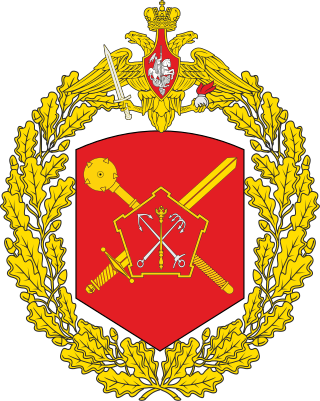The Karelian Front Russian: Карельский фронт) was a front of the Soviet Union's Red Army during World War II, and operated in Karelia.
The 100th Guards Rifle Division was an elite Red Army airborne infantry division during World War II. The division fought in the Vyborg–Petrozavodsk Offensive and the Vienna Offensive. Postwar, it was designated as an airborne division and disbanded in 1955.

The 6th Red Banner Combined Arms Army is a field army of the Red Army and the Soviet Army that was active with the Russian Ground Forces until 1998 and has been active since 2010 as the 6th Combined Arms Army. Military Unit number в/ч 31807.

The 7th Army was a Soviet Red Army field army during World War II, primarily against Finland. It was disbanded in 1944.

The 20th Guards Combined Arms Army is a field army. In 1991, after the dissolution of the Soviet Union, the army became part of the Russian Ground Forces. Military Unit Number в/ч 89425.
The 14th Army was a field army of the Soviet Army, formed twice.
The 40th Guards Rifle Division was one of a series of ten Guards rifle divisions of the Red Army formed from airborne troops in the spring and summer of 1942 in preparation for, or in response to, the German summer offensive. It fought in the Stalingrad area during that battle, eventually in the operations that encircled German 6th Army, and then continued to serve in the several campaigns in the south sector of the front, helping to liberate Ukraine and the Balkans, and ending the war at Vienna.
The 46th Army was a Soviet Red Army field army during World War II. The army was formed in August 1941 and guarded the Turkish border. During the summer of 1942, it fought in the Battle of the Caucasus. During the spring of 1943, the army helped capture Maykop and Krasnodar. During the summer of 1943, it fought in the Donbass Strategic Offensive and the Battle of the Dnieper. During early 1944, it fought in the Nikopol–Krivoi Rog Offensive and the Odessa Offensive. During the summer it fought in the Second Jassy–Kishinev Offensive. The army advanced westward and participated in the Battle of Debrecen and Budapest Offensive during the fall. After the fall of Budapest in February 1945, the army fought in the Vienna Offensive and the Prague Offensive. During the summer of 1945, the army moved to the Odessa Military District and was disbanded in September.

The 32nd Army was a formation of the Soviet Army during World War II. The army was formed twice during the war, disbanded as part of the post-war demobilization and then reformed in 1969 to protect the Soviet-Chinese border.
The 9th Guards Army was a field army of the Red Army during World War II, which fought in the Vienna Offensive and the Prague Offensive at the end of the war. The army was formed in January 1945 and included airborne divisions converted into infantry. Postwar, the army headquarters became Soviet airborne headquarters.
The 2nd Guards Airborne Division was a division of the Red Army during World War II.
The 6th Guards Airborne Division was a Red Army airborne division that fought as infantry during World War II.
The 32nd Guards Tank Division was a tank formation of the Soviet Army/Soviet Ground Forces. Its predecessor, the 9th Guards Airborne Division, was a Red Army Airborne division of World War II. On 19 June 1945, it became the 116th Guards Rifle Division. In 1946, it became the 14th Guards Mechanized Division. In 1957, it became the 14th Guards Motorized Rifle Division. In 1982, it became the 32nd Guards Tank Division, which was disbanded in June 1989.
The 114th Guards Airborne Division was a Red Army airborne division. It was first formed as the 14th Guards Airborne Division. In December 1944, it was converted to the 114th Guards Rifle Division and became an airborne unit again in June 1946.
The 37th Guards Airborne Corps was a Red Army airborne corps. The corps was established as the 37th Guards Rifle Corps on 19 January 1944. In August, it was converted into an airborne corps. On 18 December, it became an infantry corps again. The corps was converted to an airborne corps on 10 June 1946 and disbanded in June 1956.
The 114th Rifle Division began service in July 1939 as a standard Red Army rifle division, as part of the pre-war expansion of the Soviet forces. It was stationed on the Svir River front in the autumn of 1941 and had a relatively uneventful war facing the Finns until the Vyborg–Petrozavodsk Offensive began on June 10, 1944, from which point it saw much more active service. As the Finns were leaving the war the division was transferred to 14th Army in the Arctic, from where it helped to defeat and pursue the German forces from Lapland into Norway.
The 69th Covering Brigade is a unique border protection brigade of the Russian Ground Forces, stationed at Babstovo, Jewish Autonomous Oblast, and part of the 35th Army. Military Unit в/ч 61424.
The 268th Rifle Division was an infantry division of the Soviet Union's Red Army during World War II.
The 265th Motor Rifle Division was a motorized infantry division of the Soviet Army during the Cold War.




